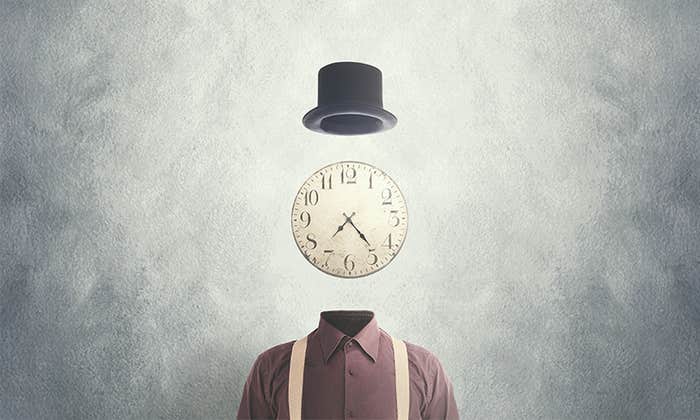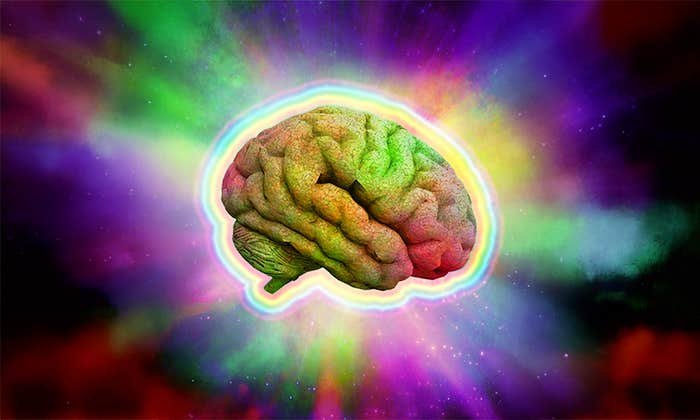Don’t look at the clock! Now tell me: How much time has passed since you first logged on to your computer today? Time may be a property of physics, but it is also a property of the mind, which ultimately makes it a product of the brain. Time measures out and shapes our lives, and how we live our lives in turn affects how we perceive the passage of time. Your sense of time is malleable and subjective—it changes in response to changing contexts and input, and it can be distorted when the brain is damaged, or affected by drugs, disease, sleep deprivation, or naturally altered states of consciousness. However, a new set of neuroscience research findings suggests that losing track of time is also intimately bound up with creativity, beauty, and rapture.
Time is most commonly manipulated by the kinds of things we do to fill it. When our minds are under-stimulated, time often feels like it is moving in slow motion, as in the scene in The Simpsons where Bart is made to lick envelopes for Principal Skinner all afternoon and groans when the clock starts ticking backward. On the other hand, when we are fully engaged, especially in the kind of “flow state” familiar to artists, athletes, and other top performers, our sense of time appears to speed up, or even to disappear entirely.
Many people describe being “enchanted” or “transfixed” when watching a live performance or viewing their favorite work of art. For example, when exploring the European paintings section of the Metropolitan Museum of Art, I enter into a kind of dissociated, transcendent state, which many people report experiencing. All of our cares and worries disappear and time seems to stand still or fade away as we become lost in the world of the story, or work of art, or the virtuosity of the performer. This loss of time-awareness mirrors the process occurring in the brains of the performers or artists while they create.
The inner critic must be shut down, and the inner Picasso turned up.
During what psychologists call “flow states,” where one is completely immersed and absorbed in a mental or physical act, people often report an altered sense of time, place, and self. It’s a transportive and pleasurable experience that people seek to achieve, and that neuroscience is now seeking to understand. A great example of flow state is found in many improvised art forms, from music to acting to comedy to poetry, also known as “spontaneous creativity.” Improvisation is a highly complex form of creative behavior that justly inspires our awe and admiration. The ability to improvise requires cognitive flexibility, divergent thinking and discipline-specific skills, and it improves with training.
Not surprisingly, the frontal regions of the brain that have been shown to be involved in time perception and impulse control are also involved in spontaneous creativity. Improvisation appears to take place in an altered state of mind/brain, and studies of the neural mechanisms of musical improvisation have identified a network of prefrontal brain regions linked to improvisation. The creative act of improvisation, at least in the musical realm, appears to be a result of changing patterns of activity in two key areas of the prefrontal cortex (PFC).
During musical improvisation, in jazz or freestyle rap, studies show a distinctive increase in medial prefrontal cortex activation. The medial prefrontal cortex (mPFC) is a brain area known to be involved in intentional, internally generated self-expression and the pursuit of goal-oriented behaviors. This makes sense, since improvised performance requires you to come up with new material in a rapid stream, and deploy it just as quickly for a listening or watching audience. The other aspect to this pattern is a decrease in lateral orbitofrontal cortex and dorsolateral prefrontal cortex activation (DLPFC). The lateral orbitofrontal cortex (OFC) and dorsolateral prefrontal cortex are brain areas involved in conscious self-monitoring, effortful problem solving, focused attention, and evaluation and regulation of goal-directed or planned behaviors. These lateral areas assess whether behaviors conform to social norms, and exert inhibitory control over inappropriate or maladaptive behavior. But as any skilled performer will tell you, inhibitions are the enemy of improvisation.
When mPFC activation is turned up, it encourages the internal generation of ideas. And when lateral PFC brain areas are simultaneously turned down, it allows novel thoughts and behaviors to emerge uninhibited, leading to divergent thinking and unfiltered creativity. In other words, the inner critic must be shut down, and the inner Picasso turned up. Deactivation of lateral PFC regions is associated with free-floating, defocused attention, allowing spontaneous associations between ideas to arise, and sudden realizations or insights to occur. Creativity appears to occur when the DLPFC decreases its regulation of the contents of consciousness, allowing for unconscious, unfiltered, or random sensations and thoughts to arise in the flow state. Just as children will play more wildly when the teacher isn’t watching, when we reduce the influence of the DLPFC on our behavior, it allows us to think more like artists.
Improvisation appears to take place in an altered state of mind.
Future research could explore whether this pattern of brain activity is in fact a neural signature of improvisation that occurs across all art forms, for instance during painting, theater, comedy, and dance improvisation, or whether the signature is unique to the musical and verbal forms it has been found in so far. When the lateral PFC regions—where our sense of agency is created after ongoing actions take place—decrease in activation, a performer’s moment-to-moment decisions and actions may feel as if they are occurring outside of time and without conscious intention, as if they are “coming from somewhere else.” This is consistent with the sentiment many artists express that their creative process is being directed by a “muse” or outside agent.
However, improvising performers are not oblivious; momentary “check-ins” to see how your performance is going can provide necessary environmental (or audience) feedback, helping to revise your approach and optimize performance in real-time. Creative thought also involves the “default mode network” (DMN), a set of brain regions active when attention is directed internally and suppressed when a person engages in externally directed tasks. The DMN is active when you’re daydreaming, but not when you’re filling out an application form, which requires executive control areas like the DLFPC. Improvisation requires a balance in activation between these two networks, reflecting the extent to which creative thought and behavior needs to be responsive to environmental input, and constrained by certain rules to meet the specific goals of the task at hand. But if you become overly self-aware or self-conscious for too long, you can lose the flow state and the performance will suffer. Of course, you don’t need a cognitive neuroscientist to tell you that. Just listen to Eminem:
You better lose yourself in the music, the moment
You own it, you better never let it go
You only get one shot, do not miss your chance to blow
This opportunity comes once in a lifetime
Luckily, you do not need to be able to improvise (or take drugs) to achieve flow states. Deactivation of the lateral PFC also occurs during other altered states of consciousness such as meditation, hypnosis, and daydreaming. And a similar pattern of dissociated activation in PFC has been identified during REM sleep, where dreaming usually occurs. Dreaming involves unplanned, irrational associations, defocused attention, an altered sense of time, and a feeling of lack of agency or volitional control (with the exception of lucid dreaming). These same characteristics are associated with creativity when one is fully awake.
The sense of time passing, producing its changes and progressions, is a capacity our brains evolved for adaptive reasons. How long have I been sleeping? How soon do the kids need to eat? How fast will I have to walk to make it home before dark? Keeping track of time is something we do instinctively, and our instincts have recently been supplemented by cultural inventions such as clocks and calendars, which train our brains to map its instincts onto scales and increments. However, we have also evolved the ability to turn off this constant time-keeping, in moments of artistic rapture or contemplation, and that adaptive sense of timelessness gives our lives much of its beauty and meaning. How we choose to spend our time, which remains our most limited and valuable resource, is one of the greatest gifts, and responsibilities, we are given.
Heather Berlin, Ph.D., MPH is a cognitive neuroscientist and assistant professor of psychiatry at the Icahn School of Medicine at Mount Sinai. She practices clinical neuropsychology at Weill Cornell Medicine in the Department of Neurological Surgery, and is a Visiting Scholar at the New York Psychoanalytic Society and Institute. She hosts Startalk All-Stars with Neil DeGrasse Tyson, and has hosted series on PBS and the Discovery Channel.
Lead image: Ricardo Ferrando / Shutterstock
This article first appeared online in our “Coordinates” issue in June, 2018.


























